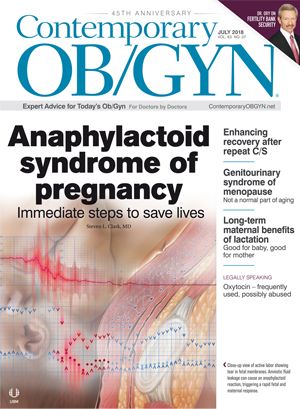ERAS: Improved outcomes post-cesarean
An ob/gyn shares her experience with implementing enhanced recovery after surgery (ERAS) and its effect on patient care at her institution
©Feng Yu - stock.adobe.com

The concept of an enhanced recovery program following elective surgery was developed more than 15 years ago.1,2 It refers to multimodal care pathways designed to accelerate patient recovery by reducing the surgical stress response and supporting the patient’s physiologic function. These procedures and anesthesia-specific pathways form an integrated continuum, as the patient moves from home through the preoperative, intraoperative, and postoperative phases of surgery and returns home again.3
A key component of enhanced recovery after surgery (ERAS) is patient and family engagement, which helps patients better prepare for surgery, hospitalization and discharge. The aim of enhanced recovery is to optimize multiple aspects of patient care, improve recovery, and facilitate earlier discharge with increasing patient satisfaction and quality of care. One of the central elements of our ERAS protocol is the application of multimodal pain interventions to reduce the reliance on opioid-based medications.
Much of the work establishing the beneï¬ts of enhanced recovery has been conducted on patients undergoing colorectal surgery, but the same concepts have since been used in gynecology, urology and orthopedics.4 Despite demonstrated success in Europe, the transition to evidence-based enhanced recovery has been slow in surgical and anesthesia practice in the United States, partly because of a lack of awareness, and also due to reluctance of some healthcare team members to embrace change.5 Until recently, there has been little interest in enhanced recovery after cesarean delivery. However, since 2012, multiple obstetrical units in the United Kingdom have introduced enhanced recovery programs in obstetrics and have demonstrated improved quality of care and significant savings with superior patient satisfaction.6-10
The Saint Peter’s/Axia experience with ERAS
The relative lack of experience with enhanced recovery after obstetrical surgery in the United States provided us with a unique opportunity to pioneer this process at Saint Peter’s University Hospital and within Axia Women’s Health. Axia Women’s Health is comprised of more than 250 physicians at over 100 patient care centers located in New Jersey and Pennsylvania. Axia provides patients a full spectrum of care in obstetrics, gynecology, fertility, maternal fetal medicine and women’s imaging centers. We launched our ERAS obstetrical pathway in 2016 for low-risk patients with the diagnosis of repeat cesarean delivery. The four tenets of our program are:
- Improved preoperative assessment, planning and preparation before admission;
- Reduced physical stress of surgery;
- A structured approach to immediate perioperative and postoperative management, including pain relief;
- Early mobilization.
To improve perioperative assessment, planning and preparation for admission, our team partnered with SeamlessMD, a leading provider of clinical intelligence platforms, to develop a smartphone application to engage and empower our patients. Our patient application has a wide range of capabilities, including the ability to provide preoperative education, timely reminders, and remote monitoring. Our analytics dashboard collects patient-generated data from across the platform. For instance, patients are prompted to report their mood, appearance of their incision, success of breastfeeding, extent of mobilization, pain scores and narcotic use for 2 weeks postoperatively. Our dashboard is monitored and becomes actionable, preventing readmissions and complications while empowering patients.
All patients receive a detailed explanation about ERAS from their obstetrician and download their application during their 36-week prenatal visit. We provide “bite-size” information at the right time using appropriate language delivered by interactive multimedia. We push notifications to patients daily about their surgery, and pre- and postoperative care. Involving patients and their families is fundamental to ERAS and empowers patients to take a significant role in and ownership over decisions regarding their care. The information significantly reduces their fear and challenges preconceived ideas about the operation, pain, recovery and length of stay.
Our second aim was to reduce the physical stress of surgery, so all patients receive a preoperative complex carbohydrate drink and 40 mg of famotidine the evening before their procedure. On the morning of surgery, patients have a second clear complex carbohydrate drink 2 to 3 hours before their scheduled cesarean delivery. This physiologically improves cortisol, insulin and glucose levels and thus recovery. Intraoperatively, we warm patients by placing a whole body warmer on the operating table to prevent hypothermia, and by warming preoperative intravenous (IV) fluids, thus controlling perioperative temperature management. We allow skin to skin in the operating room for early breastfeeding and continue this in the recovery room.
We also reduce the stress of surgery by giving all patients triple antiemetic prophylaxis with 4 mg IV ondansetron, 10 mg dexamethasone, and 10 mg metoclopramide intraoperatively. We also have a standard intraoperative protocol with a subarachnoid block with 0.75% bupivacaine and fentanyl. Additionally, 0.15 mg intrathecal morphine is added to the subarachnoid medications for postoperative pain control.
For our pain management protocol, we give two very effective non-opioid medications in alternating doses around the clock. A patient receives pain medication every 3 hours for the first 24 hours automatically. We give the nonsteroidal ant-inflammatory drugs ketorolac 30 mg IV and 1000 mg acetaminophen IV in alternating sequences. These medications are not on-demand, thus eliminating the up and down rollercoaster effect; patients are no longer over-sedated nor behind on pain control. Starting 24 hours after surgery, patients are switched to 600 mg of ibuprofen and 650 mg of acetaminophen by mouth. These are also distributed in alternating sequence and not on demand. Starting on postoperative Day 2 and only for breakthrough pain, 2 mg of hydromorphone by mouth is available on an as-needed basis.
Lastly, we improve mobilization. There is evidence to suggest that mobilization reduces incidence of venous thromboembolism and pulmonary complications.11After transfer to the post-partum floor when full motor function is confirmed, patients are helped to a chair and subsequently walk a few steps with assistance. We remove Foley catheters six hours after surgery and remove IV catheters on Day 0. By removing the Foley catheters on postoperative Day 0, patients are getting up to use the bathroom and on postoperative Day 1 they are eating all meals out of bed and walking the length of the hallways.
Outcomes with ERAS for cesarean
After launching our ERAS program in the fall of 2016, we enrolled over 100 patients in the first year. Our length of stay was reduced from 3.7 days to 2.45 days. As a result of implementing our protocol, our patients have been able to reduce narcotic use five- to six-fold. Most patients do not receive narcotic pain relief in the hospital or after discharge. Other benefits and advantages of our ERAS include minimizing disruption of eating and drinking before surgery and post-delivery, as well as increasing early skin-to-skin contact with their newborns. Patients are ambulating earlier and have their indwelling catheters removed on postoperative Day 0. We have had a 68% response rate to our patient engagement application and an increase in patient satisfaction. Patients appear to be comforted by the ability of providers to monitor their progress through our dashboard after discharge. Axia Women’s Health providers can log in to the web-based dash board from their office and follow all postoperative patients. Providers can follow patient’s pain and mood scores that they have entered on their smart phone application. We follow their breastfeeding success and patients can even send descriptions and pictures of their incision. Axia Women’s Health developed our application with SeamlessMD as a strategy to engage patients in the ERAS protocol. Developing similar communication approaches are likely important to the success of any ERAS protocol.
Conclusion
At this ob/gyn’s institution, a program that helped patients better prepare for surgery, hospitalization, and discharge resulted in shorter lengths of stay and less use of narcotics.
References:
- Kehlet H. Care after colonic operation: is it evidence-based? Results from multinational survey in Europe and the United States. J Am Coll Surg 2006;202:45-54.
- Wilmore DW. Management of patients in fast track surgery. BMJ 2001; 24(322):473-476.
- Kitching A. Fast-track surgery and anaesthesia. Continuing Education in Anaesthesia Crit Care Pain 2009;9:39-43.
- Niranjan N. Enhanced recovery after surgery–current trends in perioperative care. Update Anaesth 2010;26:18-23.
- Kahokehr, A. Implementation of ERAS and how to overcome the barriers. Int J Surgery 2009;7:16-19.
- Abell, DL. Correspondence. Enhanced recovery in obstetrics. Int J Obstet Anesth 2013;22:349-361.
- Lucas, D. Enhanced recovery in obstetrics–a new frontier? Int J Obstet Anesth 2013;22:92-95.
- Vickers, R. Enhanced recovery in obstetrics. Correspondence. Int J Obstet Anesth 2013;22:349-361.
- Halder S. Enhanced recovery programme for elective caesarean section. Arch Dis Child Fetal Neonatal. 2014;99:A19.
- Wrench, IE. Introduction of enhanced recovery for elective caesarean section enabling next day discharge: a tertiary centre experience. Int J Obstet Anesth 2015;24:124–130.
- Chandrasekaran S. Early mobilization after total knee replacement reduces the incidence of deep venous thrombosis. ANZ J Surg. 2009;79:526-9.

